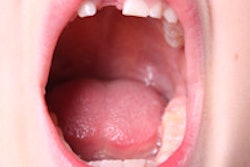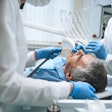
Shared dental visits in certain instances can serve dentists and their patients better than traditional one-on-one visits, according to research conducted by the Harvard School of Dental Medicine and the Cambridge Health Alliance in Massachusetts.
The results of a pilot project that used shared dental visits for preventing early childhood caries (ECC) will be presented as a poster this week at the International Association for Dental Research (IADR) meeting in Seattle.
Brian Swann, DDS, MPH, a clinical instructor in oral health policy and epidemiology at the Harvard School of Dental Medicine/Cambridge Health Alliance, was the lead researcher for the project.
"Childhood caries is the No. 1 and preventable childhood disease in the world," Dr. Swann said in an interview with DrBicuspid.com. "So let's talk about prevention."
In some communities, up to 50% of kindergartners are already affected by ECC, but there are numerous barriers to teaching prevention to their caregivers, he noted. Many parents simply don't understand the importance of oral health for infants and toddlers, he said.
"We can't expect people to come to the office and keep their appointments for infants and toddlers. They're not going to do it, because they don't understand the value of oral health for children that age," Dr. Swann said. "It's not that they have so much to do, but that they have so much to learn going forward."
Clinical personnel such as pediatricians and nurses also need to understand the importance of patient referral to dentists at an earlier age, he noted.
Barriers to access
Although Massachusetts has universal dental care for people to be seen in a community or hospital-based clinic, these services are underutilized, according to Dr. Swann. Access to providers is often problematic geographically, and the limited number of oral health providers can make it difficult to schedule visits in a timely manner. The Massachusetts team found that the no-show rate was extremely high for one-on-one visits in the toddler/caregiver group due, in part, to needing to schedule these visits far in advance because of limited providers and limited chair time.
“With the infant and toddler shared visits, we began making more of a profit.”
School of Dental Medicine
The researchers hoped that shared dental visits would increase access to providers for both preventive and urgent care, if needed, and also enhance patient education, reduce anxiety, and ultimately decrease the need for urgent care.
For this study, groups of three to eight similar-need toddlers (n = 38) were seen for seven 60-minute shared dental visits at the patients' primary care clinic. Patient files and fluoride varnish setups were arranged in a conference room so that paired chairs with a table behind them allowed for individual "knee-to-knee" exams and varnish application. Two general practice residents, along with an assistant/translator and a group facilitator, staffed the visits.
The group facilitator provided 15-minute group ECC education and solicited questions and discussion. The two residents then performed the exams, taught prophylaxis with toothbrush and toothpaste, and applied varnish. After the individual exams, the facilitators helped the caregivers schedule a six-month follow-up visit or, in the case of three patients determined to have urgent needs, make arrangements to be seen immediately.
The bottom line
In debriefings after the shared dental visits, 100% of caregivers felt that they "understood more about ECC," while 80% "found it helpful to hear from other caregivers," "were comfortable discussing issues," "had no concerns about privacy," and felt that their children "responded better to a [shared dental visit] than a single appointment."
The two general practice residents were "very satisfied" that the model allowed them to decrease repetitive information and that watching others during exams and varnish applications decreased anxiety among the patients and caregivers. The residents spent 12 to 15 minutes with each patient, 30 minutes less than the standard single general practice resident visit.
According to Dr. Swann, the model worked well because it reduced overhead and saved chair time to have all the equipment in a room that did not need to be a dental office, allowing the team to see multiple patients in a shorter period of time. Even if all the patients did not show up for the shared visit, seeing three patients in that timeframe still "broke the record" for the show rate versus one-to-one visits in the same time interval.
"With the infant and toddler shared visits, we began making more of a profit," Dr. Swann said. "We were not making a profit before."
Assessments regarding cost-effectiveness, ECC rates, and caregiver satisfaction, awareness, and understanding are ongoing. Dr. Swann's team is in discussions with Massachusetts' Women Infants and Children (WIC) program to bring similar visits to the WIC service centers, increasing provider access and early intervention for infants and children receiving public assistance.
"We have to take the dental show on the road," Dr. Swann said. "We have to take oral health to where the patients are."
Last year, Dr. Swann and his team of researchers presented a poster at IADR regarding the shared dental visit model for denture visits. Of the six visits generally needed for dentures, his team did only the first and last visits in the dental chair. Also generating profit versus the individual visits, they found that their denture patients preferred the group education and camaraderie of the shared, prompting them to pursue the model for ECC visits, Dr. Swann noted.



















